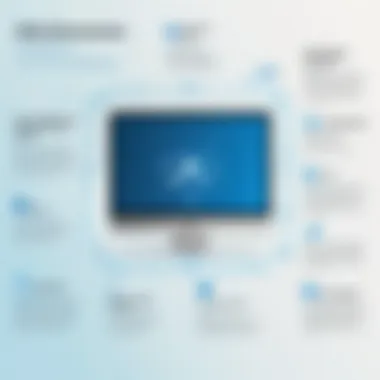Understanding RMA in IT Management for Efficiency


Intro
Return Merchandise Authorization (RMA) plays a vital role in information technology. In this age of rapid technological development, the management of hardware and software returns is crucial. An effective RMA process helps organizations maintain operational efficiency while fostering strong customer relationships. Understanding this concept is paramount for IT professionals, as it directly impacts their workflow and the quality of service they provide.
The landscape of IT is ever-changing. A robust RMA process addresses the challenges associated with product returns, from faulty hardware to software discrepancies. This article will dissect the core aspects of RMA, examining its procedures, potential difficulties, best practices, and its implications on the industry.
By delving into each of these sections, readers will gain a comprehensive understanding of RMA and its critical importance in IT management. Knowledge of RMA can aid professionals in making informed decisions, ultimately enhancing the customer experience and improving organizational efficiency.
Foreword to RMA
Return Merchandise Authorization, often abbreviated as RMA, signifies a crucial element in the management of IT resources. In essence, it is an organized system that facilitates the return of defective or unwanted products. Without a proper RMA process, handling returns can become chaotic for IT departments, resulting in inefficiencies and potential losses.
The significance of RMA extends beyond mere logistics. It ensures that organizations have a clear protocol for tracking product returns, minimizing financial impact, and managing customer expectations.
"Effective RMA processes contribute to operational efficiency and profitability within IT management."
As technology advances, that importance only grows. Many companies are adopting RMA as a fundamental aspect of their overall IT strategy. With effective RMA solutions, organizations can enhance their service levels, significantly improve customer satisfaction, and maintain streamlined operations. In the competitive landscape of information technology, optimized RMA can lead to a true competitive advantage.
Definition of RMA
RMA stands for Return Merchandise Authorization. This process involves a predefined method that companies use to authorize the return of products. Typically, when a customer identifies a defect or wants to return an item, they must request an RMA from the seller. This request indicates the intent to return, as well as the reason for the return.
The RMA system includes steps such as issuing a unique authorization number, which must be attached to the returned item. This number aids in tracking and managing the return effectively within inventory systems. RMA processes safeguard against unauthorized returns and fraud, simplifying the overall return operation.
Importance of RMA in IT
The importance of RMA in IT is multifaceted. First, it is critical for maintaining customer trust. An organized return process reassures customers that they can rely on the company for service when products do not meet their expectations. A clear RMA policy helps in building strong customer relationships, which is valuable in the tech industry.
Additionally, RMA stands as a central point in managing IT assets. IT departments often deal with expensive hardware and software, making it essential to handle returns efficiently. A structured RMA process can minimize downtime for organizations by ensuring defective components are swiftly returned and replaced.
The efficiency of RMA impacts the bottom line. Companies that navigate returns smoothly can avert financial losses associated with deadstock or defective assets. In this way, RMA is not solely a customer service tool; it is also a strategic asset that drives business performance.
The RMA Process Explained
The Return Merchandise Authorization (RMA) process is a crucial aspect of IT management. It serves as a structured method for handling the return of defective products, ensuring proper communication between suppliers and customers. This section explores the various stages of the RMA process, examining its benefits and the considerations that IT professionals must keep in mind.
Initiating an RMA Request
Initiating an RMA request is the first step in the process. This stage is critical for establishing a clear line of communication between the customer and the IT department or supplier. The request typically starts when a product malfunctions or does not meet performance expectations.
To begin, the customer must gather all necessary information about the product. Key details include the product model, serial number, purchase date, and a description of the issue experienced. Having this information ready simplifies the communication process and speeds up the initiation.
A typical RMA request may involve filling out a form on the supplier’s website or contacting customer support directly. Many companies now offer online portals that allow customers to submit requests efficiently. This can reduce wait times significantly, making the process smoother.
Effective initiation of an RMA request can lead to quicker resolutions and improved customer satisfaction.
Approval and Authorization
After submitting the RMA request, the next phase involves approval and authorization. This is where the supplier reviews the request, assessing it against their return policy. Factors such as warranty status, return timeframe, and product condition all come into play during this process.
Once the review is completed, the supplier will inform the customer of the decision. If approved, the customer receives an RMA number, authorization for return, and specific instructions on how to proceed. This number is critical, as it tracks the return and ensures proper processing.
During this stage, it is important for both parties to maintain transparent communication. If the request is denied, the supplier should clearly explain the reasons and provide guidance on alternative options. This can mitigate dissatisfaction from the customer’s side and help maintain a positive relationship.


Return Shipping Procedures
The final step in the RMA process is return shipping procedures. This phase focuses on the logistics of actually returning the product. Adhering to the supplier's instructions is vital for ensuring a smooth return.
Typically, the customer must securely package the product, attach the RMA label, and use the designated shipping method. Each supplier may have specific requirements regarding packaging and shipping to prevent damage during transit. Following these guidelines can avoid additional costs and delays.
It's wise for customers to track their shipments once they are sent. This way, they can monitor the return’s progress. Once received by the supplier, the product will go through inspection before any decisions are made regarding repair, replacement, or refund.
Types of RMA
Return Merchandise Authorization (RMA) encompasses various types tailored to different needs and scenarios in IT management. It is crucial to distinguish among these options to implement effective solutions that address specific challenges. Each type serves distinct purposes while providing flexibility in managing and processing returns. Understanding these categories can enhance efficiency, reduce costs, and improve customer satisfaction.
Standard RMA
The Standard RMA is the most common type. It involves the process where a customer requests authorization to return a defective or unsatisfactory product for repair or replacement. This process often requires the consumer to fill out an RMA form, detailing the issue, original purchase information, and desired resolution.
In most cases, after assessment, the company will issue a Return Merchandise Authorization number. This number is vital for tracking the return and ensuring proper handling within the warehouse. From an operational perspective, a clearly defined Standard RMA process can significantly minimize delays, ensuring that returns can be processed seamlessly.
Benefits of Standard RMA
- Streamlined process: Standard RMAs often lead to faster resolutions.
- Better inventory management: Quickly identifies defective units, aiding effective stock management.
- Enhanced customer communication: Keeping customers informed throughout the process improves their overall experience.
Advanced Replacement RMA
Advanced Replacement RMA offers a proactive solution for critical hardware failures. In this scenario, a company sends a replacement product to the customer before receiving the returned defective unit. This method is particularly beneficial in industries where downtime is costly.
The advanced approach minimizes disruptions by allowing customers to continue operations while awaiting repairs. It also reflects a commitment to customer service. However, organizations must consider the potential risks, such as inventory control issues and the handling of unreturned items, which can lead to losses.
Considerations with Advanced Replacement RMA
- Cost effectiveness: While this option might incur additional shipping expenses, minimizing downtime can lead to higher overall savings.
- Risk of non-return: There must be a robust follow-up process to ensure the defective unit is returned.
- Clear policies: Establishing clear terms and conditions helps manage customer expectations effectively.
Cross-shipment RMA
Cross-shipment RMA is akin to the advanced replacement model but is utilized primarily when both the company and the customer want to ensure limited downtime. Here, a replacement is shipped simultaneously with the return of the defective item, often based on agreements established beforehand.
This method is common in scenarios involving critical IT hardware, such as servers and networking equipment. Cross-shipment ensures that businesses can maintain their service levels while managing their returns effectively. However, it requires strong logistic coordination to manage shipments and returns.
Key Elements of Cross-shipment RMA
- Immediate resolution: Diminishes service interruptions as new hardware arrives before the return is processed.
- Requires strong partnership: Successful implementation often necessitates good relationships between the vendor and the customer.
- Potential for increased costs: This method can lead to higher shipping costs, which need to be justified by the benefits offered.
Understanding these types of RMA allows IT managers to choose the best practices that fit their needs, fostering better relationship with clients and enhancing operational efficiency.
The Role of RMA in Customer Support
Return Merchandise Authorization (RMA) plays a pivotal role in customer support, particularly in IT management. It serves as a systematic bridge that connects customers and the technical aspects of product returns. When a customer encounters issues with hardware or software, the RMA process guides them through resolving these issues efficiently. An effective RMA process not only preserves customer satisfaction but also reinforces the relationship between customers and companies. Understanding this role is essential, as it impacts overall customer experience and loyalty.
Enhancing Customer Satisfaction
One of the primary benefits of a well-implemented RMA process is the enhancement of customer satisfaction. When customers know that they can easily return defective or unwanted products, their confidence in the brand increases. A transparent RMA process instills trust. Here are some elements that contribute to enhanced satisfaction:
- Quick Response Times: Addressing RMA requests promptly leads to a smoother experience for customers.
- Clear Communication: Providing clear instructions helps customers understand what to expect during the return process.
- Support Accessibility: Accessible support channels, such as chatbots or hotlines, improve customer interactions before, during, and after the return process.
Companies that prioritize these factors often see an increase in customer retention and positive reviews, which are essential for long-term growth.


Managing Customer Expectations
Managing customer expectations is another crucial aspect of RMA in customer support. When customers understand what they should expect from the RMA process, it minimizes frustration. Several considerations play a key role in this:
- Transparent Policies: Detailed information about return policies should be readily available to customers. This includes timelines, conditions for returns, and any costs involved.
- Proactive Updates: Keeping customers informed about the status of their return fosters a sense of reassurance, reducing anxiety about the return process.
- Realistic Timelines: Setting realistic expectations for refunds or exchanges can help prevent misunderstandings. Providing a clear timeframe is beneficial in managing expectations.
A well-defined RMA process can turn potential customer dissatisfaction into loyalty. It acts not just as a solution for returns, but as a means to strengthen the customer relationship.
By focusing on both enhancing satisfaction and managing expectations, companies place themselves in a better position to address customer concerns effectively, ultimately contributing to a more positive experience.
Challenges Faced with RMA
The Return Merchandise Authorization process is essential for handling returns in IT management. However, this process comes with its share of challenges. Understanding these challenges is crucial for those involved in IT operations. Addressing them effectively can lead to improved processes and better overall performance. Below, we explore specific hurdles within RMA management.
Operational Hurdles
One of the key operational hurdles in RMA is managing timelines. When a returned product is not quickly processed, it can lead to delays in replacements or repairs. Such delays not only frustrate customers but can also contribute to loss of revenue. To mitigate this, organizations often need to analyze their workflows and identify bottlenecks. Evaluating
- the turnaround time for processing RMA requests
- the efficiency of the return shipping
- the effectiveness of communication between departments
is important. Streamlining these processes can enhance operational efficiency.
Communication Breakdown
Communication plays a vital role in ensuring that all parties involved have a clear understanding of the RMA process. This is where a breakdown can create problems. Miscommunication between support teams, customers, and technical personnel can lead to incorrect information regarding return eligibility, shipping instructions, or product issues. Often, the lack of a cohesive communication strategy complicates staff interactions, resulting in confusion. Establishing a centralized system for tracking RMA communications can help clear up misunderstandings. A good practice can include regularly updating all stakeholders on the status of returns and any changes in processes. This leads to a smoother workflow and better customer experiences.
Logistical Issues
Logistics is another significant challenge in the RMA process. Handling returns often requires coordinated efforts from multiple departments. If logistics processes are inefficient, they can delay the return of products. This situation can create frustration for customers and pressure on support staff.
Common logistical issues in RMA include:
- Improper tracking of returned items
- Insufficient resources to handle returns
- Complications in coordinating between warehouses
To overcome these challenges, organizations should invest in more robust inventory management systems. Utilizing technology to automatically track products as they move through the return process can significantly improve logistical efficiency. Optimizing warehouse operations can also ensure that returned items are handled in a timely manner.
Best Practices for RMA Management
Effective management of Return Merchandise Authorization (RMA) is critical for maintaining operational efficiency within IT environments. Adopting best practices can dramatically enhance the speed and accuracy of the RMA process. This section discusses several key practices that can be implemented.
Developing Efficient Processes
Creating efficient processes is the foundation of effective RMA management. Businesses should seek to standardize their procedures for handling returns. This begins with a clear and comprehensive roadmap that includes every step from product return initiation to final disposition. It is essential to document the processes thoroughly. Consider using workflow diagrams to make these paths clear to all stakeholders.
- Initial Assessment: Develop a consistent method to evaluate whether a return request meets the criteria for RMA.
- Streamlining Approvals: Automate approval processes whenever possible. Speed is often crucial here, and software can expedite decision-making.
- Feedback Loop: Regularly collect feedback from team members involved in the RMA process to identify areas for improvement.
Effective process development minimizes the chances of errors and enhances overall productivity.
Utilizing Technology
Incorporating technology into RMA management can significantly optimize operations. There are various tools available that can help manage returns more efficiently. For instance, inventory management systems and RMA tracking software can streamline the documentation and tracking processes.
- Return Management Software: Many IT companies use specialized software like Freshdesk or Zendesk that provide detailed tracking and reporting capabilities.
- Barcode Scanning: Implementing barcode or QR code systems allows for quick scanning and updated inventory.
- Customer Portals: Develop self-service portals to allow customers to initiate RMA requests independently. This reduces call volume for support teams and accelerates the process from the customer's perspective.
Technology not only enhances accuracy but also often leads to reduced processing times.


Training Staff Effectively
Staff training is an essential component of a successful RMA strategy. Employees must understand the RMA process and the importance of adherence to company protocols.
- Regular Workshops: Conduct training sessions that focus on both the procedural and technical aspects of the RMA process. This should include hands-on practice with the software and processes.
- Knowledge Base: Maintain a comprehensive knowledge base that staff can access for on-the-job training. Having resources readily available encourages self-learning.
- Performance Metrics: Develop performance metrics to measure the effectiveness of team members in handling RMA. Providing constructive feedback based on these metrics can help refine staff skills.
Regular training ensures that your team remains proficient and aware of best practices. This leads to a more streamlined RMA process and improves internal communication.
“Implementing best practices in RMA management is not just about meeting basic operational needs; it is about elevating customer satisfaction and optimizing your IT environment.”
By focusing on these key areas—developing efficient processes, utilizing technology, and training staff effectively—you can establish a robust RMA management system that minimizes disruptions and builds stronger customer relationships.
The Impact of RMA on IT Operations
The Return Merchandise Authorization (RMA) is a critical process in IT management. Its impact stretches across various dimensions of IT operations. RMA is not merely a transactional aspect; it plays a pivotal role in shaping how organizations manage hardware and software returns. With an increasingly competitive market, understanding RMA’s impact helps organizations maintain operational integrity and customer satisfaction.
Minimizing Downtime
One of the primary benefits of an efficient RMA process is the reduction of downtime. When IT equipment fails, it disrupts workflow. Downtime can lead to significant productivity loss and increased costs. A well-structured RMA procedure allows for rapid identification of issues, swift return of faulty products, and prompt replacement or repair. This reduces the time systems are out of service.
Consider these points regarding downtime:
- Immediate Response: RMA emphasizes quick assessment and resolution. A timely response to a malfunction ensures that systems are back online with minimal delays.
- Streamlined Communication: Effective communication channels within the RMA process enable swift decision making and prompt updates. This keeps all stakeholders informed.
- Technology Utilization: Leveraging technology, such as automated RMA systems, can drastically reduce manual errors and expedite processing times.
"An optimized RMA process can save hours, or even days, of lost productivity."
Cost Implications
Cost management is another essential element linked to RMA processes. Handling RMAs efficiently can lead to considerable financial benefits for organizations. High volumes of returns can be expensive due to shipping fees, restocking costs, and lost sales opportunities. Here are some financial considerations regarding RMA:
- Shipping Costs: Minimizing the number of returns through quality control practices decreases shipping and handling fees associated with returned items.
- Staff Efficiency: Streamlined RMA processes can reduce the labor costs associated with processing returns. This increases an organization's overall operational efficiency.
- Inventory Management: Effective management of returns ensures that inventory levels are optimized, avoiding unnecessary capital tied up in inactive stock.
Emerging Trends in RMA
As technology continues to evolve, Return Merchandise Authorization (RMA) systems are adapting as well. Understanding these emerging trends is crucial for IT professionals and companies looking to optimize their processes and maintain customer satisfaction. These trends not only influence operational efficiency but also mold the way businesses interact with their clients. Let's explore the two significant trends shaping the RMA landscape today: automation and shifting customer behavior.
Automation and RMA
Automation is becoming an integral part of the RMA process. With advancements in machine learning and artificial intelligence, many companies are leveraging automated systems to streamline their RMA procedures. Automation benefits include:
- Reduced response time: Automated systems can handle requests faster than human agents. This decreases the time customers wait for RMA approvals and status updates.
- Error reduction: Manual handling of RMA requests can lead to mistakes. Automated processes minimize human error, ensuring accurate order processing and returns.
- Data analysis: Automated systems can analyze data patterns in RMA requests. Companies can use this info for better inventory management and to identify recurring issues with specific products.
"Automation not only enhances efficiency but also allows human resources to focus on more complex customer needs, improving overall service delivery."
Shifts in Customer Behavior
The behaviors and expectations of customers are changing rapidly in today's digital world. With access to information and reviews at their fingertips, customers demand better service regarding RMAs. Key elements of this trend include:
- Increased expectations: Customers expect swift and transparent processes when returning products. They want to track their RMAs online and receive timely updates.
- Self-service options: Many consumers prefer handling RMAs independently. Companies that provide comprehensive self-service portals see higher satisfaction rates. Customers appreciate having control over their return processes.
- Social responsibility: Today's consumers are increasingly aware of the environmental impacts of their purchases. Companies integrating sustainable practices within their RMA processes can attract these conscientious customers.
Ending
Understanding Return Merchandise Authorization (RMA) is critical for IT professionals and organizations. The processes and practices related to RMA directly influence operational efficiency, customer satisfaction, and overall cost management. As IT environments become increasingly complex, ensuring a well-defined RMA process becomes not just a best practice but a necessity.
The Future of RMA in IT
The landscape of RMA is shifting, influenced by technological advancements and changing consumer behavior. Automation will likely play a significant role in the evolution of RMA processes. By integrating automation tools, organizations can streamline the initiation of RMA requests, reduce processing times, and enhance accuracy. Technology such as machine learning can assist in predicting returns by analyzing data patterns, allowing for proactive adjustments in inventory and staffing.
Furthermore, in light of the increasing prevalence of e-commerce, the demand for efficient and responsive RMA processes has intensified. Consumers expect swift resolutions to issues, and organizations must adapt to these heightened expectations to maintain competitiveness. Adaptation might involve flexible return policies and improved communication channels to foster transparency.
Overall, the future of RMA in IT will demand a blend of innovative solutions and robust processes. By staying ahead of trends, IT professionals can optimize customer experiences and resource management.



